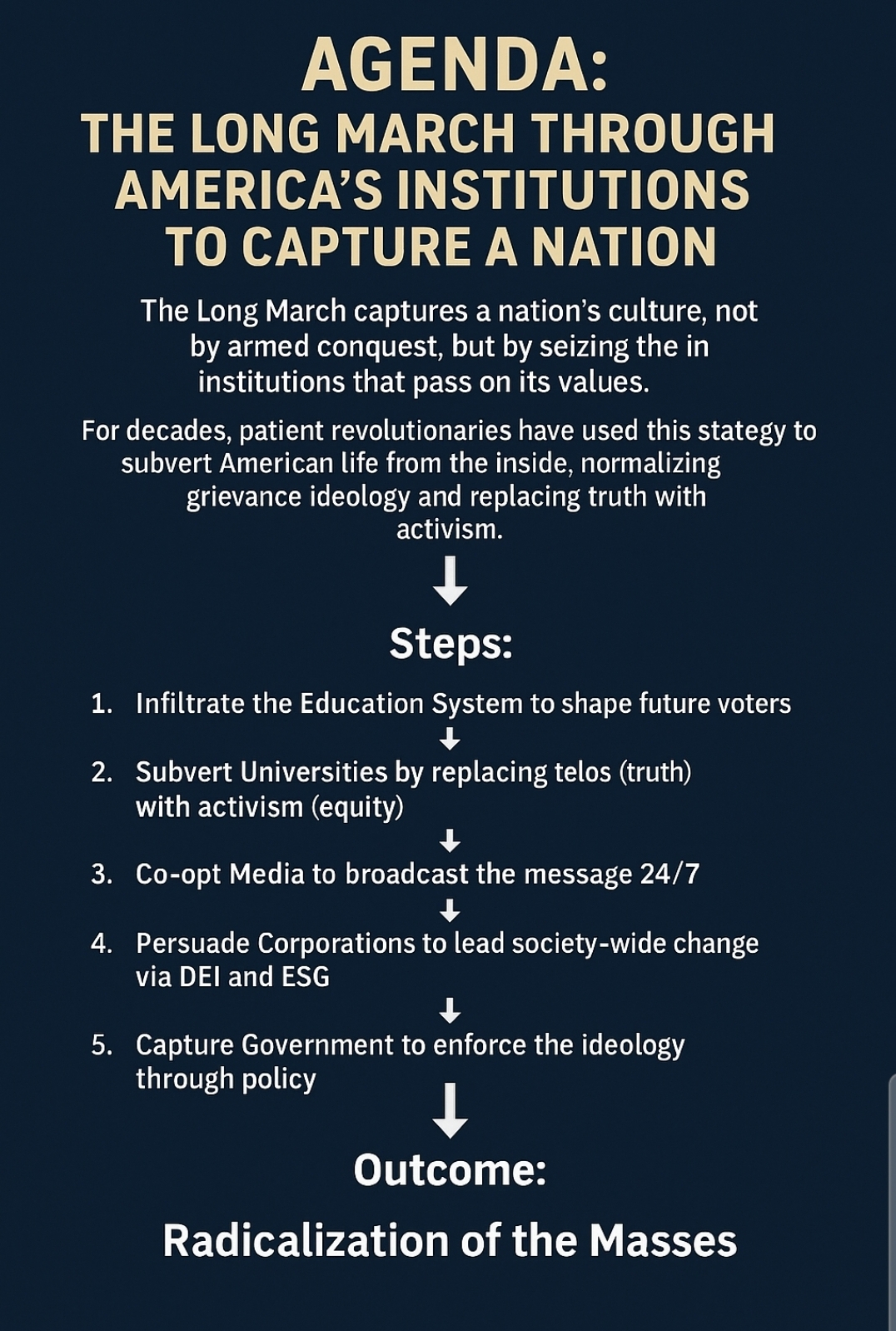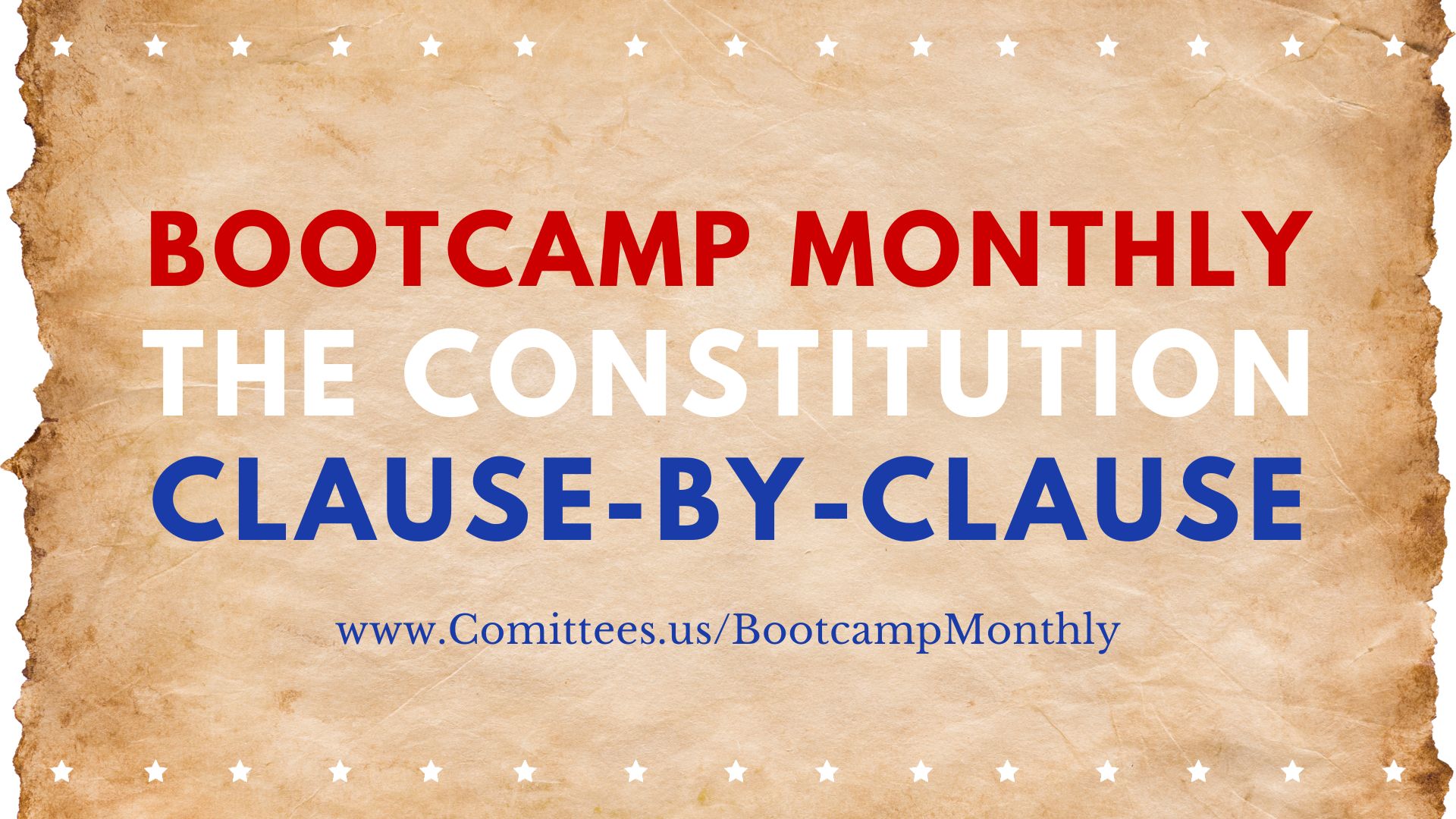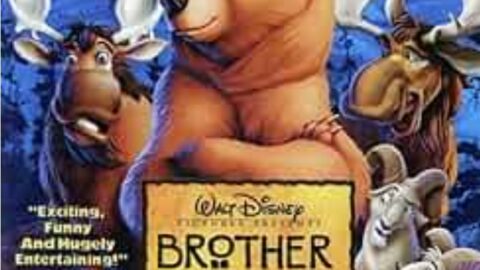“In the traditional motion picture story, the villains are usually defeated. I can make no such promise.”
Agenda: The Long March Through America’s Institutions to Capture a Nation
The article lays out how radicalization in America didn’t appear suddenly—it grew through a century-long “march” across institutions. Schools slowly shifted from teaching civic virtue and critical thinking to promoting grievance and identity categories. Universities traded their original mission of truth-seeking for activism and equity, producing activists more than scholars. Media then amplified outrage into a daily ritual, corporations codified these values through DEI and ESG frameworks, and government locked them in with laws, grants, and mandates. Step by step, what began as cultural shifts hardened into institutional capture.
Its significance today is hard to overstate. The fractures we see—polarized politics, endless culture wars, and distrust of every authority—are not random. They are the downstream result of this long march. By identifying how each sector was reshaped, the article gives clarity: these aren’t isolated problems but a coordinated cultural transformation. Understanding this history matters now, because without confronting institutional capture, citizens risk mistaking symptoms for causes—fighting today’s outrage cycle without ever touching the machinery that produces it.

So opens a film that argues America’s crisis is not an accident of history but the product of a century-long strategy: detach the nation from its moral anchors, capture the institutions that shape hearts and minds, and normalize dependence on the State. Whether one embraces or contests its thesis, the narrative connects names, movements, and milestones into a single through-line—what it calls an agenda rather than a conspiracy, because it has been advanced in the open, in plain words and public policy.
The German Marxist Rudi Dutschke famously spoke of the “long march through the institutions.” The idea was simple but devastatingly effective: rather than confront Western societies directly with revolutionary violence (as the 1960s radicals had dreamed), one could capture them slowly by embedding activists within schools, media, universities, churches, and bureaucracies. Over decades, the ideas once confined to fringe manifestos became conventional wisdom, taught in classrooms, published in textbooks, dramatized in movies, and enforced in HR departments.
Jonathan Haidt’s lecture captures the academic branch of this march: the slow shift of universities from truth-seeking guilds to activist organizations. What began in the 1990s with the rise of identity-based departments metastasized into a new telos—social justice as sacred. Faculty ratios tilted left, blasphemy laws silenced debate, and students were formed not in resilience but fragility. The very place designed to expose young minds to disconfirmation now trains them to see opposing views as heresy.
Charlie Kirk’s activism places that march in the broader arena of public education. From his vantage point, the long march wasn’t limited to elite universities—it extended downward into K–12 schooling, teacher unions, federal education bureaucracies, and standardized curricula. The result: millions of students immersed in an environment where progressive dogmas were the water they swam in. Debt-driven college pipelines ensured not just intellectual capture but financial dependence—habituating young Americans into systems where conformity is survival.
The radicalization of the left, then, is not an accident of the last five years—it is the fruit of a century of institutional capture. Step by step:
- Schools stopped prioritizing civic virtue and critical thinking, and instead normalized identity categories and grievance studies.
- Universities traded telos (truth) for activism (equity), producing activists more than scholars.
- Media amplified every grievance as moral urgency, ritualizing outrage into daily life.
- Corporations adopted DEI and ESG frameworks, codifying the same values into hiring, promotion, and capital flows.
- Government reinforced it all with policy, grants, and mandates that privileged the activist worldview over competing visions of justice or freedom.
What ties these shifts together is not secrecy but sacralization. Once certain values (equity, identity, victimhood) became sacred, questioning them became blasphemy. And when a culture adopts blasphemy laws, it radicalizes: debate becomes impossible, nuance vanishes, and escalation feels like righteousness.
The “long march” was never about overnight revolution. It was about slowly redefining what counted as normal. Today’s campus speech codes, DEI bureaucracies, fragility cultures, and activist curricula are not isolated malfunctions—they are the endgame of an agenda that has been at work for decades.
The promise of villains being defeated is, indeed, uncertain. For unlike in films, this agenda does not hide in the shadows. It thrives in daylight, sustained by institutions that once guarded liberty but now sanctify ideology. The challenge, as both Haidt and Kirk warn in their own ways, is whether enough Americans will see the capture clearly—and whether universities and schools can be reformed before they become fully radicalized engines of cultural transformation.
A Reckoning With the 20th Century
The film’s hinge point is the twentieth century—the bloodiest on record—offered as living proof that ideas about the State and the individual have consequences measured in millions of lives. It insists that socialism, fascism, and communism were not simply “alternative economic systems” tinkered with in the marketplace of ideas. They were comprehensive projects to re-engineer society by elevating government into the role of ultimate moral authority.
When the State becomes “ultimate,” there is no appeal beyond it. Law ceases to be a neutral arbiter and becomes the weapon of whoever holds power. Dissent becomes not only inconvenient but criminal. Citizens are transformed from bearers of rights into subjects of will. The gulags, show trials, and mass famines of the 20th century are not treated here as unfortunate side effects but as logical outcomes of the State declaring itself god.
By contrast, the film places the American experiment in sharp relief. Born in resistance to monarchy and consolidated through constitutional limits, the United States was envisioned not as a utopia of State power but as a republic of restrained government. Its foundation, the narrative emphasizes, was moral soil described as Judeo-Christian: the belief that each human being is created imago Dei—in the image of God—and thus endowed with dignity and unalienable rights that no ruler, party, or committee may revoke.
From this vantage point, freedom is not a spontaneous accident but a fruit on the tree of morality. It grows from roots: transcendent moral law, the recognition of human dignity, and the idea that rights pre-exist the State. Cut those roots—through secular materialism, ideological capture, or collectivist projects—and liberty withers. The 20th century becomes a stark warning: once the State is enthroned as the highest authority, freedom dies, often in rivers of blood.
This historical reckoning is not just backward-looking; it frames the stakes of today’s debates. If universities, schools, and cultural institutions reorient their telos away from truth and toward activism, if they redefine justice as equality of outcomes enforced by bureaucratic decree, they risk rehearsing the same errors of the last century in a new key. What begins as moral fervor can end as political radicalization, and what begins as equity can harden into tyranny.
The Strategy: Culture First, Politics Later
The narrative insists that the transformation of America has not been random, but deliberate—a slow-motion strategy rooted in cultural capture. Revolution in the streets, the film contends, would never succeed in a society shaped by biblical conviction, intact families, and civic traditions of liberty. The answer was subtler: revolution in the classroom, the newsroom, the pulpit, and the boardroom. Change culture, and politics will follow.
The lineage traced is unmistakable. Fabian socialism in Britain offered a model of gradualism rather than immediate revolt—its crest a wolf in sheep’s clothing. The Frankfurt School fled Nazi Germany only to carry its project of cultural critique into the American academy, popularizing the language of “political correctness.” Antonio Gramsci, writing from a prison cell, gave the blueprint: the “long march through the institutions,” whereby patient infiltration would replace violent insurrection. And Saul Alinsky, midcentury Chicago agitator, distilled the tactics of disruption into Rules for Radicals—a manual embraced by organizers across the spectrum of progressive politics.
Each layer reinforced the same premise: if you shape the cultural categories through which people see reality, you need not fire a shot. Politics will eventually bend to the new normal.
Four Recurring Targets
- Family
The traditional family—especially the two-parent, father-led household—was treated not as a stabilizer but as a barrier to transformation. Cultural products, from sitcoms to classrooms, steadily normalized cohabitation over marriage, diminished the role of fatherhood, and elevated state programs to stand in place of parental guidance. The goal was not simply personal liberation, but structural dependence: when families weaken, individuals look to the State for provision and identity.
- Faith
Biblical Christianity, with its claim of exclusive truth and transcendent authority, posed a direct threat to statist ideology. The strategy, then, was not neutrality but marginalization: portray orthodox faith as bigoted and regressive while elevating all other spiritualities as equally valid in civic life. The underlying logic: citizens who depend on God are less likely to depend on government. To displace the one is to enthrone the other.
- Education
Schools became the beachhead. What had been the transmission of knowledge—reading, reasoning, logic, history—gradually shifted to ideological formation. Teacher training programs began producing “change agents” rather than guardians of knowledge. Curriculum emphasized grievances, oppression narratives, and relativism over objective standards. In this model, students graduated knowing far more about power dynamics than about their own cultural inheritance.
- Media
From newspapers to television to Hollywood, the change was from reporting to interpretation. Stories were no longer relayed as facts to be weighed by the citizen, but as narratives already freighted with moral lessons. News anchors became advocates, actors became activists, and the power of the frame determined what a generation would accept as possible, normal, and good.
Language as a Lever
Perhaps the most powerful cultural weapon was the reengineering of language itself. Words once anchored in fixed meanings were gradually redefined:
- Social justice came to signify redistributive statism rather than impartial fairness under law.
- Tolerance shifted from enduring difference to celebrating only state-approved identities.
- Even pledges changed: from the flag and the republic, to the world and its undefined future.
The point was not neutrality but norms. Change the vocabulary, and you change the imagination. People live inside the words they inherit. Alter the words, and you alter the world.
In this telling, the radicalization of the left was not a spontaneous student uprising in the 1960s or an accidental drift in elite institutions. It was the fruit of a deliberate strategy—a cultural reshaping carried out over decades, designed to erode the moral soil that once nourished liberty.
The Meeting at Berkeley
To give its sweeping thesis a foothold in lived history, the film turns to an obscure but telling episode: a meeting in Berkeley, California, in 1992—just after the Soviet Union collapsed. The Cold War was over, communism in its Marxist-Leninist form had failed, and the world assumed that liberal democracy and free markets had triumphed. Yet, according to the film, a group of older activists—well-dressed, polished professionals rather than student radicals—gathered not to mourn the loss of revolution but to plot its evolution.
Their message was clear: the battlefield had shifted. Guns, barricades, and manifestos had failed to capture the West. What was needed now was a strategy of policy and culture, not proletarian uprisings. The revolution, they claimed, would move forward by embedding itself in the administrative state and in the values ordinary citizens would come to regard as “normal.”
Four themes dominated that Berkeley session:
- Regulate to Control
Instead of seizing factories, seize the rulebook. Environmental regulation, they argued, could be deployed not only to protect air and water but to strangle enterprise. By creating endless permits, reviews, and compliance mandates, the most productive sectors of the economy could be slowed, constrained, or re-directed toward state-approved outcomes. The rhetoric would be conservation; the effect would be control. - Divide by Identity
With class struggle no longer a persuasive organizing tool, identities would take its place. Race, gender, sexuality, ethnicity—all could be elevated into political categories, each with grievances to be managed by policy. Citizens who once saw themselves as Americans first would be re-sorted into blocs, each dependent on state recognition and protection. The more fractured the public, the stronger the state’s hand as broker and referee. - Dismantle Moral Authority
Sexual norms, long anchored in religious tradition and the natural family, were to be redefined. What older generations treated as boundaries were to be reframed as oppression. Marriage could be decentered, fatherhood portrayed as optional, motherhood as a constraint. By normalizing ever-expanding definitions of sexuality and identity, the traditional moral authorities—churches, parents, communities—would be displaced, leaving the individual more dependent on government and peers shaped by the same narrative. - Expand the State into Parenting
Early-childhood programs, once peripheral, would become a primary vehicle of socialization. By moving education earlier—before children were deeply formed by family and faith—the state could insert itself into the most intimate sphere of identity formation. The earlier the handoff, the stronger the influence. Parents would remain present, but the formative orbit would shift outward—from the family to the institution.
At the time, the film’s narrator recalls, these proposals sounded far-fetched—almost paranoid. Could America, with its deep-rooted traditions of faith, family, and freedom, really be transformed through regulatory tweaks, cultural engineering, and classroom shifts?
But a decade and a half later, the narrator insists, much of the agenda had moved from the fringe into the mainstream. Environmental policy had expanded into whole-of-government frameworks shaping industry and energy. Identity categories had multiplied into protected classes, central to politics and corporate life alike. Sexual ethics had been revolutionized, not just tolerated but celebrated in media, law, and curriculum. Early-childhood education had become a bipartisan rallying point, framed as economic necessity and social equity.
The point, the film suggests, is not that all these changes were consciously coordinated, but that they tracked exactly with what was discussed at Berkeley. What once seemed implausible now shaped the culture itself.
The narrator concludes: “The radicals of the 1960s did not disappear. They graduated. They put on suits, learned the language of policy, and carried the march from the streets into the institutions. That was the genius of Berkeley ’92: to shift from protest to permanence.”
From “Isms” to Institutions
The film argues that the 20th century’s parade of ideologies—Marxism, socialism, communism, progressivism—never truly vanished. Rather, each “ism” shed its old skin and reemerged in new forms, carrying forward the same central impulse: expand the role of the State until it becomes the arbiter of truth, morality, and daily life.
It traces this lineage like a family tree:
- Fabian Socialism in Britain, with its emblem of a wolf in sheep’s clothing, symbolized gradualism—the art of subduing resistance by appearing benign.
- The Students for a Democratic Society (SDS) of the 1960s radicalized campuses with rhetoric of liberation, which in turn spawned the Weather Underground, who took those same slogans into violent confrontation.
- By the 1980s and 1990s, the film claims, their methods had shifted again—from bombings to boardrooms, from Molotov cocktails to policy papers.
The intellectual lineage is drawn just as tightly:
- The Frankfurt School, with its project of “critical theory,” becomes the seedbed of American cultural criticism—reframed in education schools as “political correctness.”
- Antonio Gramsci’s call for a “long march through the institutions” is presented as the blueprint: capture schools, churches, unions, and media from within.
- Saul Alinsky, through Rules for Radicals, translated that blueprint into a practical manual for agitation.
- The Cloward–Piven strategy of overloading welfare and voter rolls is portrayed as a tactical cousin: overwhelm systems to force crisis and expansion of the State.
The cumulative effect, the film suggests, is not disconnected activism but a mosaic of continuity. Today’s “progressives,” it claims, inherit the mantle of these earlier movements even if they no longer use the same names. Whether called liberal, radical, or progressive, the end state is the same:
- A society administered by credentialed experts,
- Funded by redistributive taxation and debt,
- Justified by a relativist morality that de-legitimizes competing traditions.
Two Social Movements Under the Lens
The documentary devotes extended attention to second-wave feminism and the gay rights movement, framing both not simply as social causes but as strategic levers of cultural transformation.
- Second-Wave Feminism
- The film affirms women’s equal dignity and capability, but insists that mid-20th century feminism crossed a line when it redefined family roles as inherently oppressive.
- It highlights slogans describing marriage as slavery and motherhood as a “comfortable concentration camp,” portraying these not as fringe exaggerations but as mainstream currents in feminist thought.
- By recasting homemaking and child-rearing as shackles, the movement allegedly weakened the stabilizing institution of the family and made individuals more reliant on state structures for identity and security.
- The Gay Rights Movement
- Traced by the film to organizing networks with alleged communist ties in the mid-20th century, it is framed less as a grassroots plea for tolerance than as a long-term cultural wedge.
- By elevating sexuality as a primary identity and moral touchstone, the movement is said to erode the older Judeo-Christian consensus that once anchored public norms.
- The film does not focus on individual lives or private choices but on strategy: the use of sexual liberation narratives to destabilize the pre-political bonds of family, church, and community.
The Strategic Pattern
For the filmmakers, the key is not whether every activist shared the same manifesto. Rather, it is that each cause—whether economic, racial, sexual, or cultural—served the same function: loosen the loyalties that bind citizens to one another and to transcendent authority, so that the State can step in as the ultimate guarantor of identity, meaning, and provision.
This is why the title section stresses the shift “from isms to institutions.” Revolutions did not die; they graduated. They put on ties, entered universities, lobbied through legislatures, scripted television shows, and shaped school curricula. The radicalization that once raged in pamphlets and protests, the film argues, was slowly domesticated into bureaucracies and professions.
In this way, the narrative insists, the 20th century’s “isms” did not collapse. They were absorbed. They are now administered.
Schools: The Keystone
If any single institution decides the direction of a civilization, the film insists, it is education. The classroom is where loyalties are formed, where words are redefined, and where the habits of either liberty or dependency are planted. Other institutions may reinforce culture, but schools make culture generationally.
The film portrays John Dewey, often celebrated as a progressive reformer, in starkly different terms. Rather than a pragmatist bringing learning into the modern age, Dewey is depicted as a secularizer—a thinker who deliberately shifted schools away from transmitting a heritage of truth, civics, and independent reasoning. His vision of education, the film argues, was less about cultivating free citizens capable of checking power, and more about producing compliant citizens who trust experts, bureaucrats, and ultimately, the State.
This exchange, according to the narrative, unfolded slowly but decisively:
- Civics and Logic were displaced by activism and abstraction. Students were taught not the mechanics of government or the structure of argument, but the posture of grievance and the lens of interpretation.
- Content Mastery (history, math, literature) was sidelined in favor of frameworks—critical pedagogy, relativist moral reasoning, and “global citizenship” narratives that elevate identity and ideology above truth.
- Discipline and Excellence, once the hallmarks of education as training for adulthood, gave way to group identity and grievance, where performance mattered less than participation, and character formation was subordinated to sensitivity training.
The film treats this shift not as a neutral evolution but as a calculated reorientation of the school’s telos. Education no longer asks, What is true? or What is virtuous? Instead, it increasingly asks, Whose perspective is centered? Whose grievance is validated? In this way, schools stop producing independent thinkers and instead produce citizens habituated to conformity—citizens who look to authority for guidance rather than within themselves or their traditions.
The Role of Teachers’ Unions
The film identifies national teachers’ unions as the key force multipliers in this transformation. Far from neutral advocates for professional standards, they are portrayed as political actors advancing platforms that embed progressive orthodoxies across the curriculum. Examples include:
- Sex Education reframed not around health or biology but around identity and affirmation.
- Global Citizenship lessons that subordinate American civic heritage to internationalist frameworks.
- Curricula on race, gender, and power that center grievance and systemic critique while marginalizing traditional civics, patriotism, and religious perspectives.
The unions’ role, in the film’s telling, is not merely defensive but aggressive—blocking alternatives such as homeschooling, private schools, and religious education, often lobbying legislatures to restrict funding or accreditation for competitors. Where families attempt to reclaim authority over education, the unions mobilize politically to reinforce the monopoly of state-run schooling.
The Endgame
The outcome of this long project, the film argues, is a citizenry designed to need big government. Students raised without exposure to rigorous civics, moral absolutes, or intellectual discipline are less able to self-govern—economically, morally, or politically. They are primed instead to:
- See the State as provider of entitlements that replace family or community bonds.
- See the State as referee of social grievances rather than developing resilience or reconciliation within civic life.
- See the State as moral authority when transcendent anchors (faith, natural law, tradition) have been displaced.
In this framing, schools are not merely one institution among many—they are the keystone. Capture them, and the rest of society slowly reconfigures around the new norms. A nation of children trained to question their heritage but never their institutions, to prize sensitivity over resilience, and to interpret liberty as dependence on government programs, will inevitably grow into adults whose freedom is shallow and whose citizenship is fragile.
The radicalism of this approach, the film warns, is not in what is shouted in the streets but in what is whispered in the classroom: lesson by lesson, generation by generation, until the ability to think freely and live independently is replaced with the reflex to comply.
Energy and “Everythingism”
Why is the environment such a potent tool in the hands of those who want to expand the reach of the State? The film answers bluntly: because the environment is everything. “Environment” doesn’t just mean forests and rivers; it means anything that surrounds us—our homes, workplaces, neighborhoods, and even the invisible atmosphere we breathe. If the State can regulate “the environment,” then it can regulate every domain of life.
Energy becomes the central lever. Every activity in modern life—from heating and cooling a home, to growing food, to transporting goods, to powering hospitals—depends on energy. To control energy is to control the lifeblood of civilization. Thus, the film argues, when government cloaks itself in the mantle of environmental protection, it gains justification to interfere in agriculture, housing, industry, commerce, and even family life.
Fear as the Gateway
The method is not subtle: make citizens fear the sources of energy that are most affordable and reliable—coal, oil, natural gas, and even nuclear power. Label them not merely as imperfect or costly, but as existential threats to the survival of the planet. In this narrative, questioning the regulatory crusade is not prudence—it is heresy.
The film points to the 2009 “Climategate” scandal—the leak of emails from climate researchers at the University of East Anglia—as evidence that climate science had become politically motivated. In those communications, critics argued, scientists appeared to massage data, suppress dissenting voices, and present a unified front to reinforce alarming climate narratives. While defenders insisted the science remained sound, the film insists the episode revealed how political urgency, funding pressures, and ideological commitments had begun to shape the conclusions.
“Everythingism”
The film calls this strategy “Everythingism.” Once the environment becomes the frame for action, virtually everything can be brought under regulation:
- Agriculture: justified through emissions, water use, and “sustainability.”
- Transportation: controlled through fuel standards, restrictions, and mandates.
- Industry: taxed and limited under the pretext of carbon footprints.
- Private life: from the light bulbs in homes to the thermostat settings in apartments.
Because all of life consumes energy, all of life can be monitored, rationed, or restricted. The environment becomes a totalizing pretext—a justification for power at an existential scale.
Moral Urgency and the Power of Narrative
Unlike other regulatory agendas, environmentalism carries a unique moral weapon: it claims not just to improve life, but to save it. This sense of existential urgency gives it unparalleled power. Citizens who might resist bureaucratic control in other domains hesitate to question policies framed as necessary for the survival of humanity. To oppose is to appear reckless, even immoral.
The film predicts that this narrative will persist—regardless of contradictory evidence or failed predictions—because its usefulness transcends science. It delivers what the State craves most: the ability to expand authority without limits, all while wearing the mantle of moral virtue. Under “Everythingism,” regulation is no longer bounded by sector, industry, or problem. It becomes universal, justified by the claim that the fate of the planet hangs in the balance.
Networks, Power, and the Presidency
The film closes its arc by tracing not just ideas, but the networks that carried them from theory to power. What began as marginal academic notions or campus activism, it argues, eventually threaded their way into the highest levels of American politics—from the seminar room to the West Wing, from street protests to congressional chairmanships.
From Radicals to the Mainstream
The documentary insists that the Left’s greatest achievement was not winning elections in the ordinary sense, but mastering the slow game of institutional capture. Electoral cycles matter, yes—but far more decisive is shaping the pipelines that feed politics: universities that shape staffers, nonprofits that train organizers, think tanks that write policy drafts, and activist groups that frame the cultural narrative.
By the time politicians rise to the national stage, they are often surrounded by ecosystems of influence—mentors, donors, caucuses, and intellectual currents—that define their agenda more than voters ever could.
The Congressional Progressive Caucus
One focal point is the Congressional Progressive Caucus (CPC), portrayed as a bloc that amplifies the strategic goals of democratic socialist organizations and issue-specific lobbies. The CPC, according to the film, demonstrates how fringe ideas graduate into mainstream legislation once they are institutionalized. What once sounded radical in a Berkeley classroom can, within a decade, emerge as a House proposal co-signed by dozens of representatives.
This is not accidental. The film emphasizes a relay system: academics coin the frameworks, activists popularize them through protest, unions and nonprofits codify them into platforms, and caucuses translate them into legislative priorities. By the time it reaches Congress, the idea is dressed in policy language, but its lineage can be traced back through decades of organizing.
The Presidency as Fulcrum
Presidential politics, then, become less about the individual candidate and more about whether the networks behind them gain access to executive power. Cabinet picks, judicial nominations, and regulatory appointments all become the outgrowth of institutional capture. The film points to administrations where appointees had long-standing ties to progressive think tanks, activist groups, or neighborhood organizations born in the 1960s and 70s.
The message: personalities matter less than pipelines. A president is not just a leader but a conduit. And once the networks gain access to the machinery of the state, they can embed their vision into policy across agencies, often in ways the public barely notices.
Relentless, Not Accidental
The overarching claim is that the Left’s success in American politics lies not in sudden revolutions or single elections but in relentless institutional infiltration. By winning the long game—capturing schools, media, unions, cultural platforms, and caucuses—progressives created a climate in which electoral victories are simply the final step, not the foundation.
The presidency, in this telling, is the crown of a century-long march: not an office captured by chance, but the culmination of relationships, mentorships, and strategies cultivated over generations.
Are We Past the Point of No Return?
The film closes with a sobering question: has America drifted so far that recovery is impossible? Its answer is cautious but urgent—no, the point of no return has not yet been passed, but the margin for correction is narrowing.
Growth Cannot Cover Decay
The documentary argues that economic growth cannot mask cultural collapse. Charts of GDP, stock market surges, or technological innovation are meaningless if the moral fabric of society is unraveling underneath. Divorce, fatherlessness, abortion rates, rising STDs, addiction, and youth despair are presented not as isolated social problems, but as symptoms of deeper spiritual decay.
From this perspective, family instability is not a lifestyle choice but a strategic vulnerability. Without strong families, children are raised by institutions, the State fills the role of parent, and the culture becomes more malleable to top-down control. In short, the loss of family integrity erodes the immune system of a free society.
Moral Collapse as National Security
The film ties moral decline to geopolitical risk: if America falls internally, it cannot stand externally. A society divided by broken homes, fractured identity politics, and generational despair will eventually lose the will and capacity to defend itself.
- If America falls economically—through debt, dependence, or mismanagement—it will fall militarily.
- If it falls militarily, the free world loses its guarantor.
- And when vacuums appear, the film warns, they do not stay empty. Other powers—whether authoritarian states or transnational elites—rush to fill them.
A Window Still Open
Yet, the documentary resists fatalism. It insists there is still a window of hope if citizens rediscover the moral foundations of freedom. That means not just reforming policy but rebuilding character—family by family, community by community. The restoration of virtue, the strengthening of marriage, the courage to teach truth in schools and pulpits—these are framed as acts of resistance as much as acts of faith.
The closing message is both a warning and a call: America is not doomed by fate, but by choices. And the time to choose—between passivity and renewal, between dependency and responsibility, between moral collapse and revival—is running out.
What To Do: Morality Before Mechanics
The film ends where it began—not with a promise of an easy victory, but with a call to costly faithfulness. Its central thesis is blunt: the crisis is moral before it is political, and spiritual before it is economic. Without virtue, no constitution, market system, or military can save a nation. The mechanics of reform—laws, policies, elections—are necessary, but they will collapse if they are not built on a renewed moral core.
1. Repent and Rebuild the Moral Core
A free people must first be a self-governed people. The Founders assumed that liberty could only endure if citizens restrained themselves by moral conviction. The film stresses that repentance—turning away from moral compromise, cultural relativism, and passive conformity—is the non-negotiable starting point. “No technocratic fix can substitute for virtue.” Political victories are empty if families, churches, and individuals lack integrity.
2. Reclaim Formation
Education is discipleship, the film argues, and parents cannot outsource it without consequence. Children must be catechized—trained not just in skills, but in truth. That means faith rooted in Scripture, an understanding of America’s founding principles, and mastery of logic, history, and civic duty. The system as it stands catechizes in grievance and dependency. Parents must counter by choosing or building alternatives: homeschooling, private Christian schools, classical academies, or local learning pods that align formation with truth rather than ideology.
3. Create and Contend
Cultural capture cannot be undone by silence or consumption alone. The film urges a new generation of creators: writers, filmmakers, editors, podcasters, publishers. If the Left made the long march through institutions, then the Right must make a long march of creation. Produce content that is prolific, clear, and courageous. Culture shifts when truth-tellers refuse to be quiet and when citizens flood the public square with stories, art, and ideas that elevate virtue over vice.
4. Organize Locally
The film insists that power is not only in Washington but in neighborhoods, churches, and trade associations. An informed, organized minority can often beat a disorganized majority. School boards, city councils, chambers of commerce—these are the training grounds of influence. If radicals understood this for decades, so must those who care about liberty. Start where you live, and do it with others.
5. Practice Economic Stewardship
Every purchase is a vote. The film challenges viewers: stop funding corporations that bankroll the very agendas you lament. Cancel what undermines your values; support businesses, creators, and platforms that honor them. Money is leverage, and for too long, cultural conservatives have funded their opponents through passive consumerism. Redirecting economic power is both moral discipline and strategic necessity.
6. Engage Your Representatives
Politics is not ultimate, but it matters. Reward courage. Replace the pliable. Pressure the wavering. Calls, letters, donations, and local organizing matter when persistent and principled. The film underscores that politicians respond to pressure—not just from lobbyists, but from citizens who refuse to be silent. “If the righteous are absent, the corrupt will fill the vacuum.”
7. Pray, Then Act
Finally, the film grounds all action in faith. Hope is not found in rhetoric, markets, or leaders, but in God. Prayer is not an escape from responsibility but its foundation. “Faith without works is dead”: prayer must be matched by courage, sacrifice, and obedience. The closing warning is also a promise: revival begins with repentance, but history changes when repentance becomes action.

Agenda vs. Conspiracy
The film insists on a crucial distinction: a conspiracy is a secret plot; an agenda is a public list. Conspiracies operate in smoke-filled rooms, hidden from view, their existence denied until exposed. But agendas are broadcast openly—spoken from podiums, printed in party platforms, published in academic journals, taught in classrooms, and distributed in activist manuals.
The argument is stark: the radical transformation of America was never concealed in the way conspiracy theories suggest. It was announced—sometimes boldly, sometimes in coded language, but always in public view. The Fabians wore the wolf in sheep’s clothing on their crest. Gramsci wrote plainly of the “long march through the institutions.” Alinsky published Rules for Radicals as a handbook for disruption. More recently, party platforms, think tank proposals, and corporate manifestos have outlined policies that align almost perfectly with earlier radical frameworks.
The tragedy, the film suggests, is not that this march was hidden, but that so few were paying attention. While most citizens were busy raising families, working jobs, and assuming their institutions were stable, activists were writing syllabi, drafting policy papers, staffing agencies, and normalizing ideas. Decade by decade, the agenda advanced—not in secret, but in daylight, behind the very gates of institutions entrusted to guard truth.
The film points to examples:
- Party planks that explicitly champion redistributive policies, identity-based rights frameworks, and expanded state programs.
- Think tank white papers that lay out strategies for regulatory capture in energy, healthcare, and education.
- Campus syllabi that replace traditional texts with grievance-centered readings, openly teaching students to be “change agents.”
- Activist manuals that train organizers to use crisis, disruption, and redefinition of language as tools for long-term cultural change.
Each of these, the film insists, is not a secret memo but a published declaration. The issue has never been whether the Left had a plan—it has been whether the public was willing to take the plan seriously.
In this telling, the real scandal is negligence: that generations of Americans dismissed these publications as fringe, exaggerated, or harmless, while the very policies and cultural shifts they outlined were implemented step by step. By the time the effects were visible—speech codes, DEI bureaucracies, weaponized regulations, fragile students, politicized media—the agenda had already succeeded in normalizing itself.
The conclusion is clear: we are not dealing with a hidden conspiracy, but with a declared agenda. The proof is not in shadowy whispers but in the written word. The film’s warning is that unless citizens read and reckon with what has already been published, they will continue to live out someone else’s blueprint—one drafted decades ago, and one that has steadily marched through the gates of their institutions.







